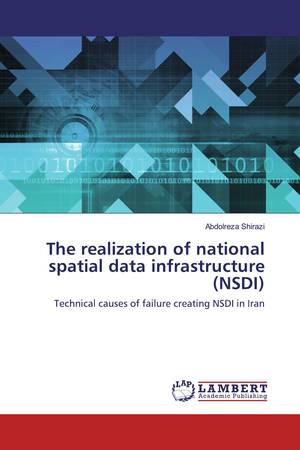کتاب The realization of national spatial data infrastructure (NSDI)
۲۶۷,۰۰۰ تومان قیمت اصلی: ۲۶۷,۰۰۰ تومان بود.۱۷۳,۵۵۰ تومانقیمت فعلی: ۱۷۳,۵۵۰ تومان.
| تعداد صفحات | 89 |
|---|---|
| شابک | 978-620-0-78473-5 |
| انتشارات |

کتاب The Realization of National Spatial Data Infrastructure (NSDI) – تحقق زیرساخت دادههای مکانی ملی
کتاب The Realization of National Spatial Data Infrastructure (NSDI) به بررسی اصول، راهبردها و چالشهای ایجاد زیرساخت دادههای مکانی ملی میپردازد. این اثر بهعنوان مرجعی جامع، به موضوعات مرتبط با جمعآوری، مدیریت و بهاشتراکگذاری دادههای مکانی در سطح ملی اختصاص دارد و راهکارهایی برای توسعه سیستمهای کارآمد ارائه میدهد.
درباره کتاب The Realization of National Spatial Data Infrastructure (NSDI)
این کتاب به مفهوم زیرساخت دادههای مکانی ملی (NSDI) میپردازد و اهمیت آن را در مدیریت پایدار منابع، برنامهریزیهای شهری، و تصمیمگیریهای استراتژیک برجسته میکند. نویسنده با ارائه مثالها و مطالعات موردی از کشورها و پروژههای موفق، به بررسی چگونگی پیادهسازی NSDI و تأثیر آن بر بهبود همکاریهای بینبخشی و تسریع توسعه میپردازد.
موضوعات کلیدی کتاب
- تعریف NSDI: معرفی زیرساخت دادههای مکانی ملی و اهمیت آن در دنیای مدرن.
- مدیریت دادههای مکانی: راهکارهای جمعآوری، استانداردسازی و بهاشتراکگذاری اطلاعات.
- چالشهای پیادهسازی: بررسی موانع فنی، سازمانی و حقوقی در اجرای NSDI.
- همکاری بینبخشی: نقش همکاریهای ملی و بینالمللی در موفقیت این زیرساخت.
- مطالعات موردی: تحلیل پروژههای موفق NSDI از سراسر جهان.
ویژگیهای برجسته کتاب The Realization of National Spatial Data Infrastructure (NSDI)
- رویکرد جامع: پوشش تمامی جنبههای مرتبط با طراحی و اجرای NSDI.
- مطالعات واقعی: ارائه مثالهای کاربردی از پروژههای ملی و بینالمللی.
- تحلیل فنی و مدیریتی: بررسی تکنیکها و راهبردهای مدیریت دادههای مکانی.
- مناسب برای تصمیمگیران: منبعی ارزشمند برای مدیران و سیاستگذاران.
چرا کتاب The Realization of National Spatial Data Infrastructure (NSDI) را بخوانید؟
اگر به دنبال درک عمیقتری از اهمیت دادههای مکانی در توسعه ملی هستید یا به حوزه برنامهریزی، مدیریت شهری، یا فناوریهای مکانمحور علاقه دارید، این کتاب اطلاعات مفیدی برای شما فراهم میکند. مطالعه این اثر، دیدگاه جامعی از چگونگی تحقق زیرساخت دادههای مکانی ملی و تأثیر آن بر بهبود فرآیندهای تصمیمگیری ارائه میدهد.
مخاطبان کتاب The Realization of National Spatial Data Infrastructure (NSDI)
- مدیران دولتی و سیاستگذاران: برای برنامهریزی و اجرای پروژههای NSDI.
- متخصصان GIS و دادههای مکانی: برای بهبود مهارتهای حرفهای و درک بهتر مفاهیم NSDI.
- پژوهشگران و دانشجویان: بهعنوان منبعی جامع برای تحقیقات در زمینه دادههای مکانی.
- طراحان سیستمهای مکانی: برای طراحی و پیادهسازی سیستمهای کارآمد.
سفارش کتاب The Realization of National Spatial Data Infrastructure (NSDI)
برای خرید کتاب The Realization of National Spatial Data Infrastructure (NSDI) و آشنایی با روشهای نوین مدیریت دادههای مکانی، به بخش فروشگاه سایت مراجعه کنید یا با ما تماس بگیرید. این کتاب راهنمایی جامع برای تحقق و استفاده بهینه از زیرساختهای دادههای مکانی ملی است.
📘 پرسش و پاسخ درباره کتاب The Realization of National Spatial Data Infrastructure (NSDI)
🔹 بخش اول: معرفی و اهداف
❓ ۱. هدف اصلی کتاب چیست؟
🔹 هدف اصلی این کتاب بررسی و تحلیل چالشها و مشکلات مربوط به پیادهسازی زیرساخت دادههای مکانی ملی (NSDI) در ایران است. کتاب همچنین به ارائه راهکارهایی برای حل این مشکلات و بهبود روند پیادهسازی NSDI میپردازد.
❓ ۲. اهمیت دادههای مکانی در این کتاب چگونه بیان شده است؟
🔹 دادههای مکانی به دلیل نقش حیاتی که در تصمیمگیریهای مدیریتی، توسعه پایدار، و سیاستگذاریهای مختلف دارند، از اهمیت بالایی برخوردارند. این دادهها در بسیاری از بخشها مانند مدیریت منابع طبیعی، برنامهریزی شهری، و حفاظت از محیط زیست کاربرد دارند.
🔹 بخش دوم: مدل مفهومی و چالشها
❓ ۳. مدل مفهومی SDI چیست؟
🔹 مدل مفهومی SDI به مجموعهای از منابع، سیاستها، و فناوریها اشاره دارد که برای جمعآوری، ذخیره، و به اشتراکگذاری دادههای مکانی ایجاد میشود. این مدل شامل عناصر مختلفی مانند استانداردها، خدمات داده، و زیرساختهای اطلاعاتی است که به تسهیل تبادل دادهها کمک میکند.
❓ ۴. مشکلات پیادهسازی NSDI در ایران چیست؟
🔹 مشکلات اصلی شامل ضعف در زیرساختهای فنی، کمبود قوانین و سیاستهای حمایتکننده، چالشهای فرهنگی و آگاهی کاربران، و مشکلات در یکپارچهسازی دادهها هستند. این مشکلات باعث کندی در پیشرفت پیادهسازی NSDI در کشور شده است.
🔹 بخش سوم: راهکارها و ارزیابیها
❓ ۵. چه راهکارهایی برای حل مشکلات پیادهسازی NSDI در ایران پیشنهاد شده است؟
🔹 کتاب راهکارهایی مانند بهبود زیرساختهای فناوری اطلاعات، آموزش و آگاهیرسانی به کاربران، اصلاح قوانین و سیاستها، و تقویت همکاری میان سازمانها و بخشهای مختلف را برای حل مشکلات پیادهسازی NSDI پیشنهاد میدهد.
❓ ۶. معماریهای مختلف سرور دادههای مکانی چگونه دستهبندی شدهاند؟
🔹 معماریهای سرور دادههای مکانی شامل مدلهای مختلفی هستند که بر اساس نیازهای خاص هر کشور و منطقه میتوانند طراحی شوند. این مدلها شامل سرورهای مرکزی، توزیعشده، و ابرمحور هستند که هر کدام مزایا و معایب خاص خود را دارند.
🔹 بخش چهارم: ارزیابی راهکارها و نتایج نهایی
❓ ۷. ارزیابی عملی راهکارهای پیشنهادی چگونه انجام شده است؟
🔹 ارزیابی عملی شامل بررسی صحت و اعتبار راهکارهای پیشنهادی در محیطهای واقعی است. این ارزیابیها نشان میدهند که آیا راهکارهای ارائه شده میتوانند مشکلات موجود را حل کرده و در شرایط واقعی موثر باشند.
❓ ۸. چه پیشنهادات فنی و غیر فنی برای بهبود وضعیت NSDI در ایران مطرح شده است؟
🔹 پیشنهادات فنی شامل بهبود زیرساختهای شبکه و داده، استانداردسازی دادهها و خدمات، و استفاده از فناوریهای نوین مانند دادههای کلان و اینترنت اشیاء است. پیشنهادات غیر فنی شامل ارتقاء آگاهی عمومی، آموزش کاربران، و ایجاد همکاریهای بینسازمانی است.
🔹 بخش پنجم: نتایج و توصیهها
❓ ۹. نتایج کلی کتاب چه چیزی را نشان میدهد؟
🔹 نتایج کتاب نشان میدهد که پیادهسازی موفق NSDI در ایران نیازمند اصلاحات اساسی در ساختارهای فنی و مدیریتی است. همچنین، توجه به چالشهای فرهنگی و استفاده بهینه از فناوریهای جدید میتواند به تسریع پیادهسازی این زیرساخت کمک کند.
❓ ۱۰. چه توصیههایی برای مطالعات آینده در این حوزه وجود دارد؟
🔹 توصیهها شامل بررسی تجربیات دیگر کشورها در زمینه پیادهسازی NSDI، تحقیق در زمینه تاثیرات اقتصادی و اجتماعی NSDI بر جامعه، و توسعه مدلهای نوآورانه برای مدیریت دادههای مکانی در کشورهای در حال توسعه است.
📌 نکات کلیدی:
- NSDI به عنوان زیرساختی برای به اشتراکگذاری دادههای مکانی در سطح ملی، میتواند در تصمیمگیریهای دولتی و بهبود عملکرد اقتصادی موثر باشد.
- مشکلات اصلی پیادهسازی NSDI در ایران شامل چالشهای فنی، فرهنگی، و سیاسی است.
- راهکارهای عملی برای حل این مشکلات شامل بهبود زیرساختهای فناوری، آموزش و آگاهیرسانی، و اصلاح قوانین و سیاستها است.
| تعداد صفحات | 89 |
|---|---|
| شابک | 978-620-0-78473-5 |
| انتشارات |
محصولات مشابه
-
کتاب Assessing Interactional Competence through paired speaking tasks
۲۷۶,۰۰۰ تومانقیمت اصلی: ۲۷۶,۰۰۰ تومان بود.۱۷۹,۴۰۰ تومانقیمت فعلی: ۱۷۹,۴۰۰ تومان. -
کتاب Automated software debugging solutions
۲۱۰,۰۰۰ تومانقیمت اصلی: ۲۱۰,۰۰۰ تومان بود.۱۵۷,۵۰۰ تومانقیمت فعلی: ۱۵۷,۵۰۰ تومان. -
کتاب Evaluation of strategic human resource planning (SHRP)
۲۹۱,۰۰۰ تومانقیمت اصلی: ۲۹۱,۰۰۰ تومان بود.۱۷۳,۱۴۵ تومانقیمت فعلی: ۱۷۳,۱۴۵ تومان. -
کتاب Compound Effect
۲۱۰,۰۰۰ تومانقیمت اصلی: ۲۱۰,۰۰۰ تومان بود.۱۵۷,۵۰۰ تومانقیمت فعلی: ۱۵۷,۵۰۰ تومان.












